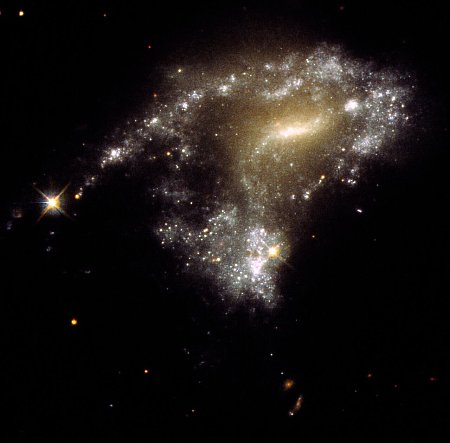A galaxy with a tail of star-forming clusters
Cool image time! The picture to the right, reduced and sharpened to post here, was taken by the Hubble Space Telescope as part of a survey of twelve different galaxies that have long tails. In this case, the galaxy is named Arp-Madore 1054-325, and the tail that trails off in the upper left is caused by the gravity of the nearby neighboring galaxy, which I think is the patch of stars just below it. Within it are many star clusters where new stars are forming. From the caption:
A team of astronomers used a combination of new observations and archival data to get ages and masses of tidal tail star clusters. They found that these clusters are very young — only 10 million years old. And they seem to be forming at the same rate along tails stretching for thousands of light-years. “It’s a surprise to see lots of the young objects in the tails. It tells us a lot about cluster formation efficiency,” said lead author Michael Rodruck of Randolph-Macon College in Ashland, Virginia.
Before the mergers, the galaxies were rich in dusty clouds of molecular hydrogen that may have simply remained inert. But the clouds got jostled and bumped into each other during the encounters. This compressed the hydrogen to the point where it precipitated a firestorm of star birth.
In some ways this galaxy portends one possible future of the Milky Way, after it collides with the nearby Andromeda galaxy in the far future.
On Christmas Eve 1968 three Americans became the first humans to visit another world. What they did to celebrate was unexpected and profound, and will be remembered throughout all human history. Genesis: the Story of Apollo 8, Robert Zimmerman's classic history of humanity's first journey to another world, tells that story, and it is now available as both an ebook and an audiobook, both with a foreword by Valerie Anders and a new introduction by Robert Zimmerman.
The print edition can be purchased at Amazon or from any other book seller. If you want an autographed copy the price is $60 for the hardback and $45 for the paperback, plus $8 shipping for each. Go here for purchasing details. The ebook is available everywhere for $5.99 (before discount) at amazon, or direct from my ebook publisher, ebookit. If you buy it from ebookit you don't support the big tech companies and the author gets a bigger cut much sooner.
The audiobook is also available at all these vendors, and is also free with a 30-day trial membership to Audible.
"Not simply about one mission, [Genesis] is also the history of America's quest for the moon... Zimmerman has done a masterful job of tying disparate events together into a solid account of one of America's greatest human triumphs."--San Antonio Express-News
Cool image time! The picture to the right, reduced and sharpened to post here, was taken by the Hubble Space Telescope as part of a survey of twelve different galaxies that have long tails. In this case, the galaxy is named Arp-Madore 1054-325, and the tail that trails off in the upper left is caused by the gravity of the nearby neighboring galaxy, which I think is the patch of stars just below it. Within it are many star clusters where new stars are forming. From the caption:
A team of astronomers used a combination of new observations and archival data to get ages and masses of tidal tail star clusters. They found that these clusters are very young — only 10 million years old. And they seem to be forming at the same rate along tails stretching for thousands of light-years. “It’s a surprise to see lots of the young objects in the tails. It tells us a lot about cluster formation efficiency,” said lead author Michael Rodruck of Randolph-Macon College in Ashland, Virginia.
Before the mergers, the galaxies were rich in dusty clouds of molecular hydrogen that may have simply remained inert. But the clouds got jostled and bumped into each other during the encounters. This compressed the hydrogen to the point where it precipitated a firestorm of star birth.
In some ways this galaxy portends one possible future of the Milky Way, after it collides with the nearby Andromeda galaxy in the far future.
On Christmas Eve 1968 three Americans became the first humans to visit another world. What they did to celebrate was unexpected and profound, and will be remembered throughout all human history. Genesis: the Story of Apollo 8, Robert Zimmerman's classic history of humanity's first journey to another world, tells that story, and it is now available as both an ebook and an audiobook, both with a foreword by Valerie Anders and a new introduction by Robert Zimmerman.
The print edition can be purchased at Amazon or from any other book seller. If you want an autographed copy the price is $60 for the hardback and $45 for the paperback, plus $8 shipping for each. Go here for purchasing details. The ebook is available everywhere for $5.99 (before discount) at amazon, or direct from my ebook publisher, ebookit. If you buy it from ebookit you don't support the big tech companies and the author gets a bigger cut much sooner.
The audiobook is also available at all these vendors, and is also free with a 30-day trial membership to Audible.
"Not simply about one mission, [Genesis] is also the history of America's quest for the moon... Zimmerman has done a masterful job of tying disparate events together into a solid account of one of America's greatest human triumphs."--San Antonio Express-News



For some reason this image reminds me of William ‘Tyger, Tyger, Burning Bright’ Blake.
The right side of the image looks like a question mark! We should call it the “Question Mark galaxy”.